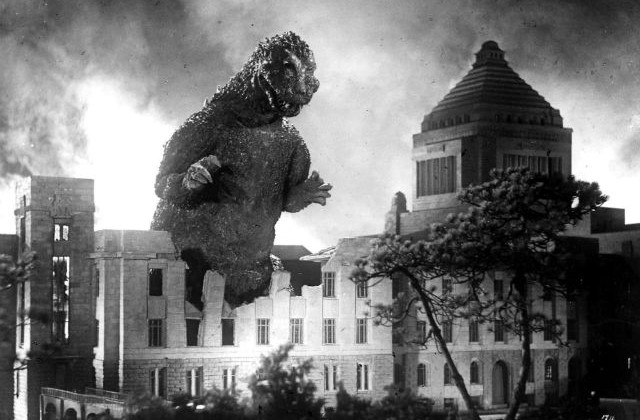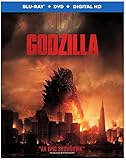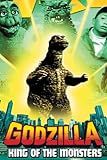A superior version of Godzilla … from 1954

A few years before ‘Godzilla, King Of The Monsters’ hit the United States in 1956, the little-seen and vastly superior Japanese ‘Gojira’ stomped its way onto the silver screen. If you remember Godzilla fondly from your youth, you’ll relish its predecessor.
As a kid growing up in Southern California, Godzilla, King Of The Monsters wasn’t about the deeper meaning and not-so-subtle references to World War II’s turning point or the horrors of war.
I didn’t care anything about that. (More accurately, I didn’t know any better.) None of my friends did.
We were just thrilled with the giant monster aspect. And Godzilla was the pinnacle of those thrills, the epitome of giant monster flicks.
So imagine my further thrill years later when I discovered there was so much more to Godzilla than simply fond childhood memories of the rampant destruction of Tokyo by sheer kaiju brute force and devastating atomic breath; Godzilla, King Of The Monsters wasn’t the original film at all but a hastily put together, Americanized version utilizing just over an hour’s worth of the Japanese Gojira, the superior, deeper and thought-provoking forerunner to the classic Godzilla more commonly known to the masses.
I was riveted to the screen when reporter Steve Martin (Raymond Burr) detailed Tokyo’s ruination from the rampaging Godzilla each time it graced the family television set, times that were too few and frustratingly far between as a kid. I was equally riveted at finally getting a copy of Gojira to see what was cut out of and changed in the film, how it differed from what I affectionately recalled from those youthful years. Was it a completely different film as I’d heard?
Knowing Gojira — which preceded Godzilla, King Of The Monsters by a couple years — was filmed in its original Japanese wasn’t daunting in the least to me. (I know a lot of people have problems with viewing a foreign film. Many folks are thrown by the incomprehensibility of a different tongue just as much as they are by subtitles flashing at the bottom of their screens, things that can and do contribute to the lack of enjoyment of non-English speaking films.) But I’m not one of them. And in fact Gojira, in its nascent form, is truly different than its bastard son … and not just in its language. It’s a more jarring and empathetic film, it’s a longer running film (clocking in at almost 100 minutes versus the 80 or so minutes of the Americanized version) not to mention it’s a captivating and intriguing piece of film making.
The idea Gojira was (and still is) firmly enmeshed with glaring comparisons and references to the World War II bombings of Japan less than a decade prior to its original 1954 release. A majority of those haunting images and scenarios were effectively slashed from the English version with only bare bones snippets left intact. This is one of the most obvious differences found when you compare the films side by side. They aren’t the most telling, however. There are a few scenes that had to have chilled the blood of some movie-goers of the time Gojira was released with the war still fresh in memory:
In one scene a physician runs a Geiger counter over a child in the aftermath of one of Godzilla’s rampages; the counter ticks wildly indicating horrifically the child’s exposure to radiation. In another, a mother comforts her daughter as the sound of Godzilla’s wrath plays out all around her. (“We’ll see daddy in heaven” the mother says in an effort to placate the girl.) There’s also a scene with a commuter train filled with Japanese verbalizing their fears about the creature. (“I hope I didn’t survive Nagasaki for nothing” one woman hrmphs.) Not so blood chilling — but equally as poignant — is a council meeting debating whether the monster’s affiliation with H-bomb testing should be revealed, sparking possible public hysteria. There are plenty more examples such as these removed from the Raymond Burr interpretation. Observers of the original realize each instance of excisement hugely alters one Godzilla rendition from the other.
One really interesting notice in Gojira was the presence of gratuitous (for the time) nudity. There are scenes of topless women when a fishing boat survivor washes ashore early on in the film which really surprised me. This is something that couldn’t possibly be present in Godzilla, King Of The Monsters … could it? But, on review, there it was. The exact same scenes, never cut from the original. I reasoned my fascination with the film was the monster aspect and had nothing to do with underlying morals or otherwise. Of course, this was all part of the intrigue of getting my first glimpse of Gojira and the fun of comparing one film to the other.
The flush of excitement of the version I saw as a kid will forever remain. Come on! Giant, destructive monsters! The stuff of popcorn Saturday afternoons and thrills and chills! And that’s why the recent reboot held (and, for me, delivered) such promise. Just as arousing though is Gojira and all its ominous undertones.
This Halloween? I suggest you go “old school” and kindle a different sort of scare instead of the glut of current slasher flicks or shallow horror schlock. Expand your mind. Get retro, go kaiju … and go Gojira instead.
 CliqueClack
CliqueClack


